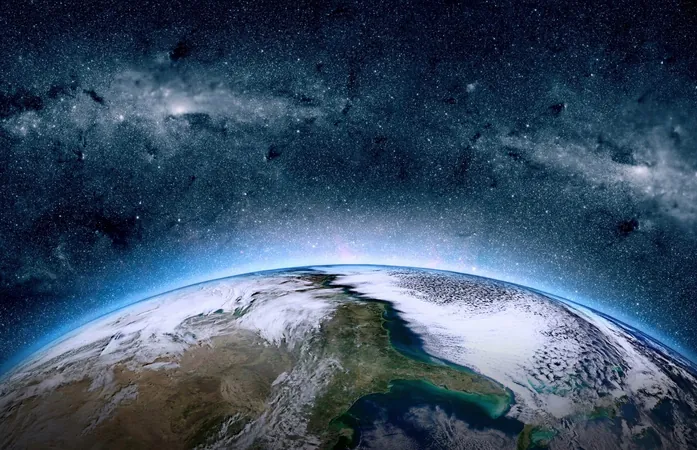
LEXI: A Groundbreaking Mission to Monitor Earth's Magnetosphere from the Moon!
2025-01-06
Author: Emma
LEXI: A Groundbreaking Mission to Monitor Earth's Magnetosphere from the Moon!
As humanity stares into the vast mysteries of the universe, the moon has always served as an emblem of our cosmic curiosity. The allure of outer space, with its moon, planets, and stars, has captivated our imaginations for centuries. Now, we stand on the brink of a new chapter that promises to deepen our understanding of Earth's protective shield: its magnetic field.
Enter LEXI: The Lunar Environment Heliospheric X-ray Imager
In conjunction with NASA’s ambitious Artemis program, a new era in space exploration is dawning. Among the instruments making their debut is LEXI, the Lunar Environment Heliospheric X-ray Imager, designed to provide unprecedented insights into our planet's magnetosphere. Delivered as part of NASA's Commercial Lunar Payload Services (CLPS) initiative, LEXI is set to embark on a transformative mission.
Starting its journey from NASA’s Kennedy Space Center in Florida, LEXI will travel to the moon on Firefly Aerospace’s Blue Ghost Lander. Once safely stationed on the lunar surface, LEXI will begin its groundbreaking task: capturing the first comprehensive images of Earth's magnetic field.
A Scientific Leap with Practical Implications
During a critical six-day observational window, LEXI will record X-ray emissions emitted at the edges of Earth’s magnetosphere. These high-energy X-rays are created when solar wind particles collide with the magnetic field—Earth's invisible shield against harmful solar radiation. The images gathered will reveal how the magnetosphere reacts to cosmic forces and variances in solar wind, including its ability to guard against streams of charged particles, which can trigger stunning auroras but also pose a risk to our satellites and electrical infrastructure.
"We’re trying to capture a holistic view of Earth’s space environment. This isn’t just complex physics; it’s science you can virtually see in action,” explained Brian Walsh, a space physicist at Boston University and the lead investigator for LEXI.
Revolutionizing Our Understanding of Earth's Magnetosphere
For the first time, LEXI will provide an unobstructed view of the magnetosphere’s dynamics. The instrument's lunar vantage point will allow it to monitor how this immense field "breathes"—contracting and expanding in response to solar wind. The expectation is to visually capture the magnetosphere's rhythmic responses as it adjusts to varying solar pressures.
"By observing these fluctuations, we can understand how our planet's magnetic shield interacts with solar winds, revealing a lot about space weather effects that impact us back on Earth,” noted Hyunju Connor, a NASA lead scientist for LEXI.
A Decade in the Making
The journey of LEXI actually began more than ten years ago under a different name—STORM. Following its successful test launch in 2012, where it gathered pioneering data on low-energy X-rays, the device was put on hold. However, with the CLPS initiative's call for lunar missions, LEXI was brilliantly repurposed for its lunar journey.
After necessary refurbishments and advancements, the once-collective technology of STORM evolved into LEXI, poised to unveil mysteries that could reshape our comprehension of both our planet and the universe.
The Bigger Picture: Exploring New Frontiers
With missions like LEXI’s integral to NASA’s plans under the Artemis program, we are not only advancing our scientific knowledge but also promoting the growth of a commercial space industry. NASA aims to work collaboratively with these emerging ventures to expand our presence on the Moon and beyond.
As we continue to unveil the mysteries of the cosmos, through missions like LEXI and broader efforts tied to NASA's Artemis campaign, the prospect of understanding the unseen forces around us grows ever closer. So, buckle up, space fans—the future of space exploration is just getting started!



 Brasil (PT)
Brasil (PT)
 Canada (EN)
Canada (EN)
 Chile (ES)
Chile (ES)
 Česko (CS)
Česko (CS)
 대한민국 (KO)
대한민국 (KO)
 España (ES)
España (ES)
 France (FR)
France (FR)
 Hong Kong (EN)
Hong Kong (EN)
 Italia (IT)
Italia (IT)
 日本 (JA)
日本 (JA)
 Magyarország (HU)
Magyarország (HU)
 Norge (NO)
Norge (NO)
 Polska (PL)
Polska (PL)
 Schweiz (DE)
Schweiz (DE)
 Singapore (EN)
Singapore (EN)
 Sverige (SV)
Sverige (SV)
 Suomi (FI)
Suomi (FI)
 Türkiye (TR)
Türkiye (TR)
 الإمارات العربية المتحدة (AR)
الإمارات العربية المتحدة (AR)